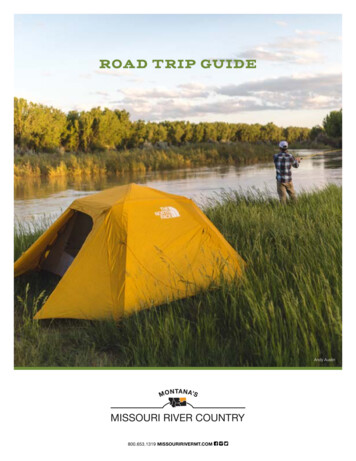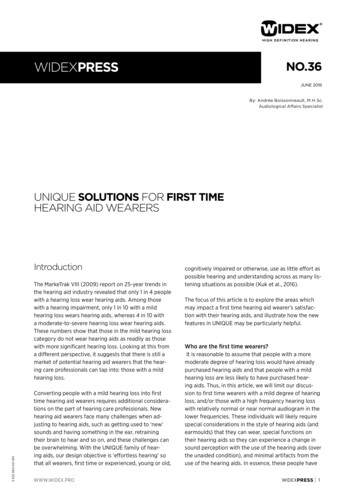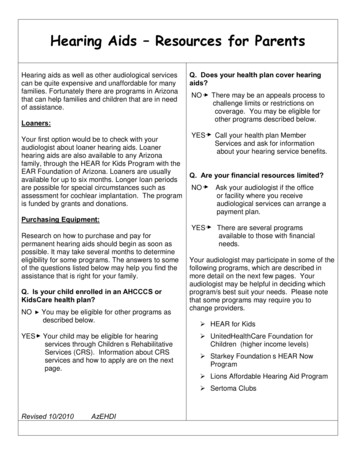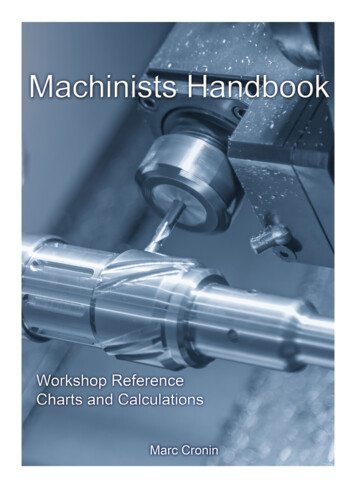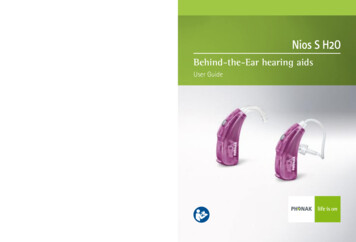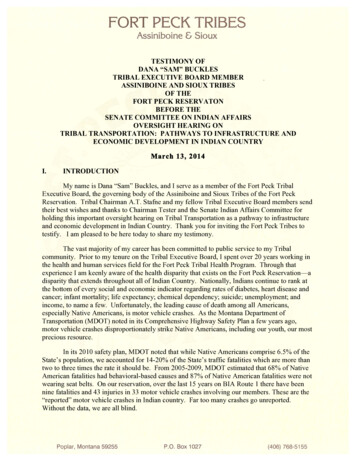
Transcription
TESTIMONY OFDANA “SAM” BUCKLESTRIBAL EXECUTIVE BOARD MEMBERASSINIBOINE AND SIOUX TRIBESOF THEFORT PECK RESERVATONBEFORE THESENATE COMMITTEE ON INDIAN AFFAIRSOVERSIGHT HEARING ONTRIBAL TRANSPORTATION: PATHWAYS TO INFRASTRUCTURE ANDECONOMIC DEVELOPMENT IN INDIAN COUNTRYMarch 13, 2014I.INTRODUCTIONMy name is Dana “Sam” Buckles, and I serve as a member of the Fort Peck TribalExecutive Board, the governing body of the Assiniboine and Sioux Tribes of the Fort PeckReservation. Tribal Chairman A.T. Stafne and my fellow Tribal Executive Board members sendtheir best wishes and thanks to Chairman Tester and the Senate Indian Affairs Committee forholding this important oversight hearing on Tribal Transportation as a pathway to infrastructureand economic development in Indian Country. Thank you for inviting the Fort Peck Tribes totestify. I am pleased to be here today to share my testimony.The vast majority of my career has been committed to public service to my Tribalcommunity. Prior to my tenure on the Tribal Executive Board, I spent over 20 years working inthe health and human services field for the Fort Peck Tribal Health Program. Through thatexperience I am keenly aware of the health disparity that exists on the Fort Peck Reservation—adisparity that extends throughout all of Indian Country. Nationally, Indians continue to rank atthe bottom of every social and economic indicator regarding rates of diabetes, heart disease andcancer; infant mortality; life expectancy; chemical dependency; suicide; unemployment; andincome, to name a few. Unfortunately, the leading cause of death among all Americans,especially Native Americans, is motor vehicle crashes. As the Montana Department ofTransportation (MDOT) noted in its Comprehensive Highway Safety Plan a few years ago,motor vehicle crashes disproportionately strike Native Americans, including our youth, our mostprecious resource.In its 2010 safety plan, MDOT noted that while Native Americans comprise 6.5% of theState’s population, we accounted for 14-20% of the State’s traffic fatalities which are more thantwo to three times the rate it should be. From 2005-2009, MDOT estimated that 68% of NativeAmerican fatalities had behavioral-based causes and 87% of Native American fatalities were notwearing seat belts. On our reservation, over the last 15 years on BIA Route 1 there have beennine fatalities and 43 injuries in 33 motor vehicle crashes involving our members. These are the“reported” motor vehicle crashes in Indian country. Far too many crashes go unreported.Without the data, we are all blind.
Sadly, these conditions are a direct result of federal policies over the last two centuries,and in particular, the federal government’s failure to invest in infrastructure and economicdevelopment in Indian Country. Funding for the Tribal Transportation Program -- 450 millionfor 566 Federally recognized Indian tribes -- has not increased since FY 2009, and in fact wentdown under MAP-21 as the Tribal bridge program was folded into the allocation formula,Congress terminated the Public Lands Highway Discretionary Grant Program and elected not toappropriate a single dollar for the Tribal High Priority Project Program.Tribal governments are capable transportation providers when given the adequateresources. The American Recovery and Reinvestment Act (ARRA) demonstrated our capacityto quickly utilize transportation construction and road maintenance funding to address thebacklog of transportation projects. Indian tribes are in the best position, as the localgovernment, to tackle long-term economic development, public safety, education, health careand housing needs provided we have basic infrastructure to support our communities, includingsafe and modern designed transportation systems.Empowering and strengthening Tribal governments and protecting the well being of ourmembers fulfill the Federal Government’s unique trust responsibility to the Indian nations. Torectify the economic and physical barriers that hinder so many aspects of Reservation life, weurge the Indian Affairs Committee to enact a long-term bill highway bill that provides financialpredictability and certainty which ensures the Highway Trust Fund (HTF) until a politicallyviable substitute is in place and with sufficient funding for Indian tribes based on our welldocumented transportation infrastructure needs. We request that any such legislation include thefollowing key elements which we request you support and convey to the Senate committeescharged with drafting the next highway bill:1. Tribal Transportation Program (TTP) – Increase annual funding to 800 million inFY 2015 and include stepped increases of 50 million per year thereafter;2. Tribal Transit Program - Increase the existing Tribal transit formula amount to 35million for FY 2014 with annual increases of 5 million, and increase discretionaryfunding to 10 million in FY 2015 with annual growth of 5 million;3. Tribal Highway Safety Set-Aside – Establish a 2% direct Tribal funding set-asidefrom the Highway Safety Improvement Program and increase the NHTSA TribalSafety Program set-aside to 3.5% to reduce the unacceptably high incidence of motorvehicle fatalities among Native Americans;4. Obligation Limitation Deduction – Restore the exemption that once existed for theObligation Limitation deduction that removes tens of millions of dollars from theTTP;5. Federal-Aid Program - Ease the transfer of Federal-Aid funds from State Departmentsof Transportation (State DOTs) to Tribes by allowing BIA or the FHWA to awardState-administered federal-aid funds to tribes under existing federal agreements;2
6. Tribal Eligibility for All Federal Grants - Ensure Tribal eligibility as a direct recipientfor all U.S. Department of Transportation discretionary and competitive grants.7. ERFO – Improve the speed and efficiency of getting ERFO funds to tribalgovernments for emergency use;8. Tribal Asset Management Program – Establish a tribal Asset Management Program at 50 million in FY 2015 with annual increases of 5 million for BIA and Triballyowned transportation facilities;9. Unused Obligation Authority – Redistribute 10% of unused obligation authority forthe TTP to fund competitive grants to remotely located tribes and restore HTFallocations for the Tribal High Priority Project Program; and10. BIA Right-of-Way Management – Direct the BIA to update and computerize rightsof-way documentation, support tribal “corridor management” practices and authorize 10 million to cover implementation and any trespass damages for unrecorded orimproperly recorded BIA rights-of-way over Indian lands.II.THE OPPORTUNITIES AND CHALLENGES OF ECONOMIC DEVELOPMENTON THE FORT PECK RESEVATIONA.Safety ConcernsThe Fort Peck Reservation encompasses 2.1 million acres--over two thousand squaremiles--in remote northeastern Montana. The Assiniboine and Sioux Tribes and individual Indianallottees own about 1 million acres of land on the Reservation. Nearly 10,000 residents live onthe Reservation with roughly two-thirds of them Tribal members and non-member Indians.The Tribes are responsible for the repair and reconstruction of nearly 400 miles of BIAsystem and Tribally-owned transportation facilities on the Reservation. Governments that have ataxable base have the resources to properly maintain and reconstruct transportation facilities. Wedo not have these resources. Our transportation infrastructure badly shows its age and what wedo reconstruct we must replace far sooner than if we had the resources, equipment and labor toproperly and routinely maintain it.Our existing formula allocation does not permit us to plan, design and build new routesthat must be built and maintain our existing inventory of transportation facilities. While theprospect of economic development from the Bakken and Three Forks oil formations is exciting,our infrastructure is woefully unprepared and we are concerned about safety.The Fort Peck Reservation lies within the western part of the Williston Basin, whichincludes many oil producing formations, including the Bakken and Three Forks. As you knowthe horizontal drilling techniques and hydraulic fracture stimulation or more commonly“fracking,” have brought about unprecedented oil development in the Bakken and Three Forksimmediately adjacent to our Reservation in western North Dakota and eastern Montana. As theclosest neighbors to this development, our substandard infrastructure--particularly our roads—has come under significant stress, without any accompanying income from development.3
Rail, truck and motor vehicle traffic has increased across the Reservation at alarmingrates moving oil, people, development related products such as frac sand and pipe, in and out ofthe Bakken. However, the Reservation road system was not designed to handle the heavy trafficthat is now the norm. Other than U.S. Highway No. 2, a federal-aid highway that runs along thesouthern boundary of the Reservation, the roads on our Reservation were built to accommodatepassenger and agriculture transportation. These roads were meant for two-ton grain trucks andschool buses. They were not designed to handle tractor-trailer combinations.B.Inadequate Road Maintenance Funding Undermines Tribal GrowthU.S. Highway No. 2 has served as the primary artery for travel between all of the majorReservation communities. However, as most direct route to the Bakken from the west, Highway2 is now congested and dangerous even as it passes through our Reservation, one of the mostsparsely populated regions of the country. This phenomenon has introduced yet another serioushealth and safety concern to our Reservation community. Moreover, the on-going need formaintenance on Highway 2 has forced traffic onto Tribal roadway and transit systems. If all ofour 533,138 allocated by the BIA for Road Maintenance were put to our inventory of roads, itwould total less than 1,350 per road mile. With staff, equipment, sand, salt and gasoline, it iswell below that level. Even with our “repurposing” Tribal Transportation Program (TTP)construction dollars for road maintenance needs, as is permitted under MAP-21, we do not havethe resources to properly maintain our routes. If routes are not routinely maintained in Montana,they deteriorate far faster than would otherwise be the case.Our biggest maintenance expense is snow removal which occupies us from Novemberthrough March. Road maintenance is an essential public safety service, especially in rural,remote Indian reservations where first responders and trauma centers are few and far between. Ifour roads are not well maintained, they contribute to the high incidence of motor vehicle crashes,fatalities and serious injuries among our members and other Reservation residents. This taxesour IHS funds to treat victims of motor vehicle crashes, both short-term and long-term healthcare needs.Over the years many groups have advocated for the enhancement of Highway 2 acrossthe northern plains as popularized by the 4 for 2 campaign. While we continue to support thoseefforts, we recognize that even if conditions existed to fund such a significant project it wouldnot alleviate the current problems for many years.The BIA Road Maintenance Program, funded at about 25 million for roughly 30 years,is the leaky bucket which undermines every national and tribal goal for Indian country. Withoutroutine road maintenance, our routes deteriorate far sooner than would otherwise be the case.Poorly maintained routes undermine our efforts to improve economic development, publicsafety, health care, and education. We encourage the Committee to urge the Interior Departmentand the Office of Management and Budget to support an annual budget of 150 million for theBIA Road Maintenance Program to protect the public as well as the public’s investment intransportation infrastructure.4
III.ADDRESSING CRUMBLING INFRASTRUCTURE AND STRUGGLINGECONOMY THROUGH TRIBAL TRANSPORATIONFirst, the statutory formula for allocating money to the Tribes through Map-21 asintroduced by Senator Baucus and his co-sponsors should be included in any re-authorization ofa new Highway Bill. While it is difficult to arrive at a funding formula that provides fairnessacross the diversity of Indian Country, we believe this proposed formula adequately protectslarge, rural tribes like Fort Peck, while considering the needs of smaller tribes as well.Second, we join our partners in Tribal Transportation Unity Caucus and the RockyMountain Transportation Planners Association in urging Congress to enact a new surfacetransportation bill – the Tribal Transportation Unity Act – to address tribal transportation systemneeds. The proposed legislation, a summary of which we included above, recognizes thecapacity of Tribal Nations to deliver transportation services to Tribal membership and the public.While we support the Tribal Transportation Unity Act as developed and agreed upon last monthin Denver, Colorado, our support for a guaranteed minimum funding amount of 75,000 forsmall Indian tribes is expressly conditioned on the TTP Program growing sufficiently to ensurethat such minimum funding level is not at the expense of large land-based tribes such as the FortPeck Tribes. In our view, the TTP formula funding levels must be determined by consideringroads, land and population. We endorse the entire package and therefore increased fundinglevels.With the Tribal shares of TTP funding we receive, we hire approximately 27-30individuals each construction season for roughly seven months. This employs members locally,who can support their families and contribute to the local economy.With our construction dollars, we have successfully completed North Park Road, a 3.2mile reconstruction project, replacing three large culverts, gravel, paving and chip sealing. Wecompleted 8.4 miles of overlay-chip seal on various routes on the Reservation. We completedSouth Wolf Point Street, a 4 mile project of milling, leveling and overlay and we beganconstruction of the Veterans Memorial with Montana Community Transportation EnhancementProgram (CTEP) funds. We also started construction on the Detention Center Parking lot andGeorge Washington Roads project. These projects will be paved this calendar year.In 2014, we are also undertaking the phased construction of the 30 mile Wolf Point –Wiota project over three years. The first phase of the project will replace two metal culverts withtwo box culverts and mill overlay. In addition, we are undertaking a bike path/pedestrianwalkway from the Airport housing addition and crossing Highway 2 to the convenience storeusing CTEP funds. We are also planning to construct a frontage road for a new Wellness Centerbeing built.This year, we received approximately 413,000 in safety grant funding. With these fundswe will restripe 26 miles of BIA routes, make road improvements to Box Elder to Blair, preparePublic Service Announcements (PSAs), and update our Tribal highway safety plan.More than a generation ago, when this Committee was considering important changes tothe Indian Self-Determination and Education Assistance Act, the Committee noted thechallenges faced primarily by rural Indian tribes, especially the challenges of basic governmental5
infrastructure, such as roads. I cannot think of a more tangible expression of governmentalservices than building and maintaining roads, bridges and transit systems that connectcommunities, generate jobs and protect Tribal and non-member residents every day.Transportation infrastructure is our foundation for a better tomorrow. On behalf of theAssiniboine & Sioux Tribes, I thank you Mr. Chairman and this entire Committee for all youhave done for us and for all Indian tribes. I urge you to share our transportation legislativerequests with the rest of the Senate. If enacted, the next highway bill will give us the tools weneed in the 21st Century to not only survive, but to thrive and build our own successes.I thank the Committee for the opportunity to present this testimony.6
cancer; infant mortality; life expectancy; chemical dependency; suicide; unemployment; and income, to name a few. Unfortunately, the leading cause of death among all Americans, especially Native Americans, is motor vehicle crashes. As the Montana Department of Transportation (MDOT) noted in its Comprehensive Highway Safety Plan a few years ago,
